#viking seax
Explore tagged Tumblr posts
Text
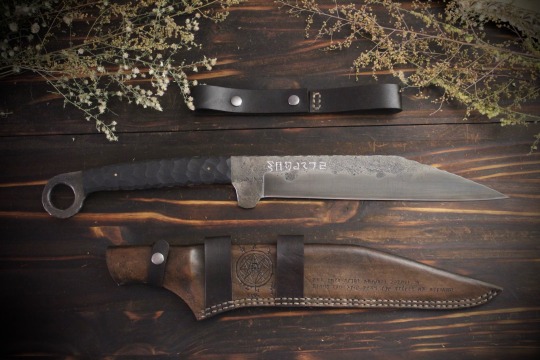
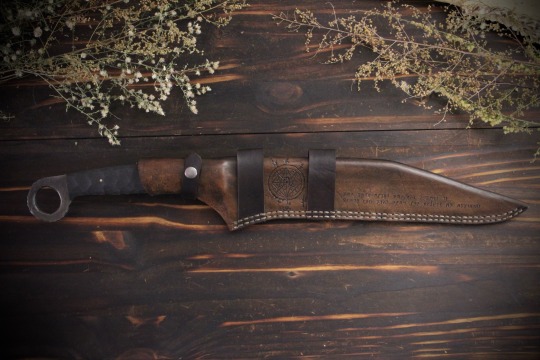

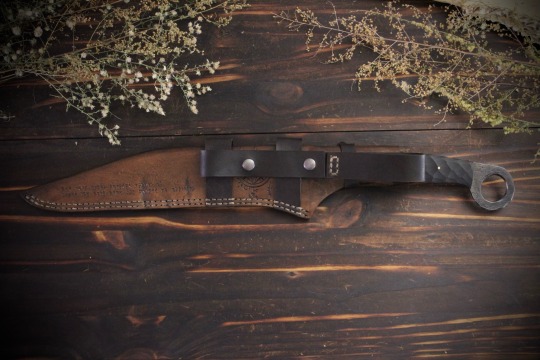
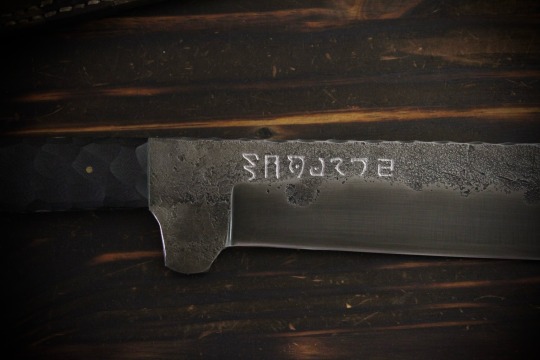

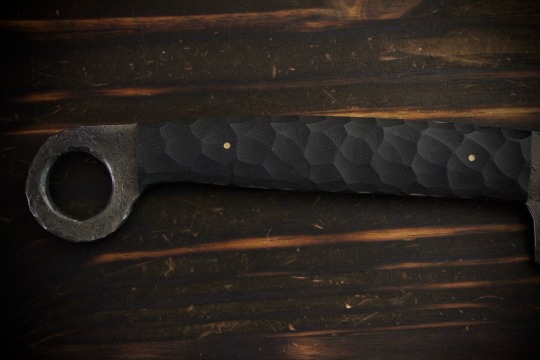

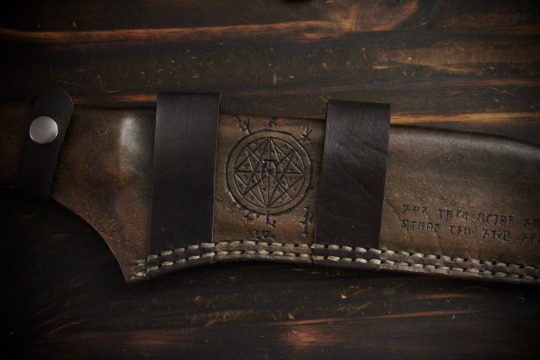
Hey everyone!! Here’s a deadric inspired blade from a few different sources! The blade it self is called “scourge” with deadric text. Check out the link here for more info.
#lunarlightforge#handforged#handmade#hand forged#handcrafted#leatherwork#bushcraft#seax#bushcraftknife#viking seax#leathercraft#oblivion#skyrim#morrowind#deadric#deadrictext
245 notes
·
View notes
Text

Anglo Saxon Seax
Anglo Saxon Seax. Visit: https://noblie.eu/wp-content/uploads/2024/05/anglo-saxon-seax.jpeg
2 notes
·
View notes
Text
Skjaldmaer!

by Linda Easterling
513 notes
·
View notes
Text

making this the official introductory post for all my future doodles and ramblings about the

Metalocalypse Vikings AU

I don't know how much effort I'll put into this, but musings below the cut! (And don't expect total historic accuracy - it's just for funsies, not a research project.)
All my future posts in this setting will be tagged with #MtlVikingsAU for ease of keeping tabs on them.
my co-conspirator, as always, is @aidoneira 💛
Setting:
Circa 840 c.e. near what will become modern day Göteborg, Sweden. The Viking Age is in full swing in Scandinavia. Seafaring Norsemen have begun to launch raids across Northern Europe and elsewhere.
Skwisgaar:
Skwisgaar is the Jarl (Chieftain) of a sprawling seaside town near modern-day Göteborg, having amassed a large army and in possession of an entire fleet of ships. An incredibly skilled swordsman rumored to be sired by a god, he is a formidable raider and has seen great success pillaging and plundering, folding smaller nearby villages into his own and going abroad for more exotic spoils. While charming, he has a cruel streak and a propensity for violence; success like his does not often come peacefully, and defending that which he and his forefathers built - what the gods have bestowed upon him - is his top priority. Lately, he's taken an interest in taming (or perhaps breaking completely) the wild spirit of his recent captive, Toki. For his thunderous nature and strength, he's earned the epithet "Þórshestr" - Thor's-Horse, or Thunder-Horse.
Toki:
Toki hails from a small village nestled deep in a fjord near what is today Stavanger, Norway. Trained as a strong warrior, he was the only survivor of a raid on his home by Skwisgaar’s army, having been barely subdued, captured, and brought back to Skwisgaar’s domain as a prize. While normally quiet and gentle, the fury with which he's able to fight as a Berserker is frightening. His skills with a blade (his preferred weapon being his seax) are second only to Skwisgaar’s. Some in the village whisper that he may even be more powerful than Jarl Skwisgaar himself... Toki finds companionship in the other captives pressed into Skwisgaar’s service. His speed and ferocity in battle have earned him the epithet "Snæfalk" - Snow-Falcon.
Runke:
Also a Norwegian captive brought to Skwisgaar’s village several years ago, Runke's jobs are many - he's able to carve and read runes, decipher omens, maintain a knowledge of various medicinal herbs and plants, and treat battlefield injuries. While some of these duties are typically seen as women's work - belonging to the class of the siðasveinn or völva - no one can deny his skill. For his wisdom (and beak-like profile), he's often called "Huginn" after Odin's own raven. He's made a begrudging sort of peace with his new lot in life and accepts his fate, even developing a soft spot for Toki who has become like a(n annoying) younger brother.
Týr:
A local of Skwisgaar’s village, Týr is a career soldier and Skwisgaar’s long-time guard and combat tutor - and the closest thing Skwisgaar has to an earthly father. In his younger years, Týr spent time going a-viking with his fellow warriors, but in recent times, he's been enjoying a slower state of semi-retirement, woodworking instead of sparring. He taught Skwisgaar everything he knows about wielding a blade. Despite his acuity with a sword, he is a kind and fair man, and has done his best to impart the same values to Skwisgaar (with limited success...) "Týr" is not his birth name, but a name he's earned after the god of war and justice himself. His birth name has been lost to time.
#making this the official introductory post to this au#my art#tuulidraws#metalocalypse#mtl#au#MtlVikingsAU#toki wartooth#skwisgaar skwigelf#mtl týr#runke snogge#feel free to yap at me or drop ideas
92 notes
·
View notes
Text
@nimblermortal sent me this last week:
A second blade weapon became increasingly common in the later Viking Age. It does not have a formal name, being often referred to as a fighting-knife or battle-knife, and it was essentially a development of the one-handed, long seax knife of the Migration Period. A single-edged blade with a thick back that added weight to a short, stabbing blow, it seems to have been intended as a back-up weapon. By the tenth century, battle-knives had elaborate scabbards that were worn horizontally along the belt, allowing them to be drawn across the body from behind a shield if the sword was gone; a variant hung down at an angle from an elaborate harness. It seems they may also have been worn on the back - again for a swift, over-the-shoulder draw. Children of Ash and Elm by Neil Price @petermorwood (Mr Morwood! Mr Morwood!) I found an archaeologist claiming people were doing over-the-shoulder draws! Would you care to weigh in?
*****
Would I ever! That's a button well pushed. But things got odd when I tried, because as soon as I'd written even the smallest reply and saved to Draft, this happened:
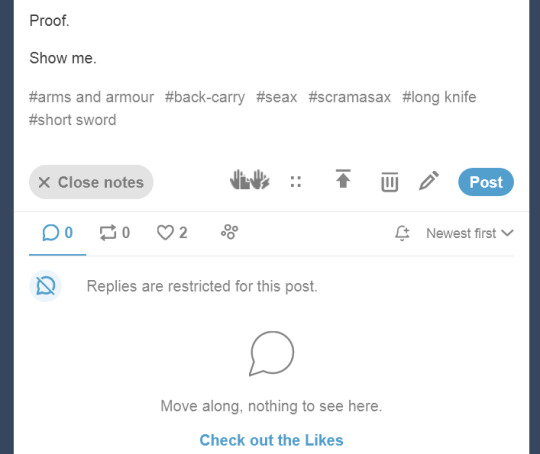
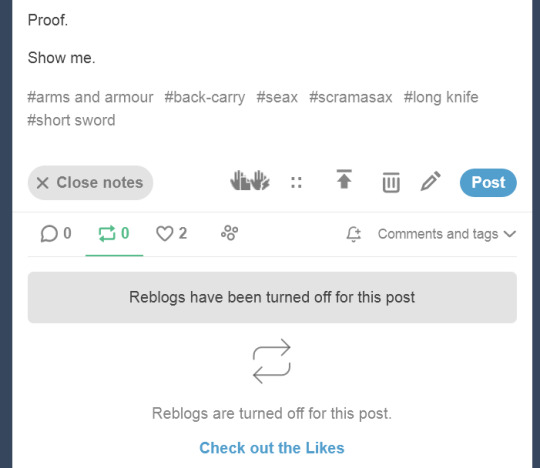
Letting it stand would have seemed like I was trying to avoid comments, corrections or criticism, but despite poking around in Settings there was no way to turn things on. It was only by cut-and-pasting @nimblermortal's entire original as a Quote starting a new post that the problem was resolved.
Anyone else encountered this?
Anyway, on with the lecture response. :->
*****
As regards Back-Carry / Back-Draw of "battle-knives", I'm not convinced.
("Battle-knife" is a term I've never seen in connection with any Viking Age weapon. What's the Old Norse for it? German "Kriegsmesser" (war-knife) refers to something much bigger from 500 years later, also not back-carried or back-drawn - which from here on will be BD / BC.)
To get where he is now, a full professor, Neil Price will have defended his PhD, and should know such a statement as "It seems they may..." will need evidence to support it.
That phrase is easy to write, as is "According to legend..." and "It is said..." However these are IMO default History Channel phrases, with all the authenticity that implies. None of them actually PROVE what they're speculating.
"Experiments conducted by museum staff wearing authentic armour reveal that IT SEEMS medieval knights could use smartphones."
But does it prove medieval knights USED smartphones? See what I mean?
*****
I first asked if anyone had actual proof of BC / BD on Netsword almost 30 years ago, and to date there's been nothing. I've also posted about it quite a lot on Tumblr, so being poked with this particular stick is no surprise. :->
The quotation from "Children of Ash and Elm" is the first time I've heard of a trained archaeologist making a claim for BC / BD, and the odd part is that Prof. Price also states the weapon was intended for "...a short, stabbing blow" - which means wearing it horizontally in front makes far more sense. From that position it can be drawn far faster and with less telegraphed intent than "...on the back - again for a swift, over-the-shoulder draw."
Reaching up for any weapon carried across the back, whether long or short, is a bigger movement - and thus less "swift" - than snatching out the same weapon worn at the hip or across the front at waist level, especially if - as he suggests - that move is masked behind a shield (or for that matter a cloak, a door, or a half-turned torso...)
Try both moves in front of a mirror with a ruler or even a length of dowel, and you'll understand.
With a weapon-hilt visible behind one shoulder or just a cross-belt suggesting something slung out of sight, what's a Norse warrior going to think when his potential opponent reaches up there? At a moment of hot words and high tension, will he wait while an itchy back gets scratched or until an attack happens?
The explosive violence described in sagas suggests not.
If Prof. Price has solid proof for his BC / BD notion in the form of artefacts or art - and it'll need more than a one-off example - I'll be very pleased to finally see some "show me" evidence.
(It won't do anything for longswords of 500 years later, of course, though I bet the uncritical back-carry brigade would leap on it regardless.)
But without that evidence, I'm taking "it seems" with a wary pinch of salt.
*****
There's a weird internet fixation about BC / BD (which are NOT the same thing) and an equally weird need to show that back-draw "works", whether with hooks under the guard and a leather condom at the point...
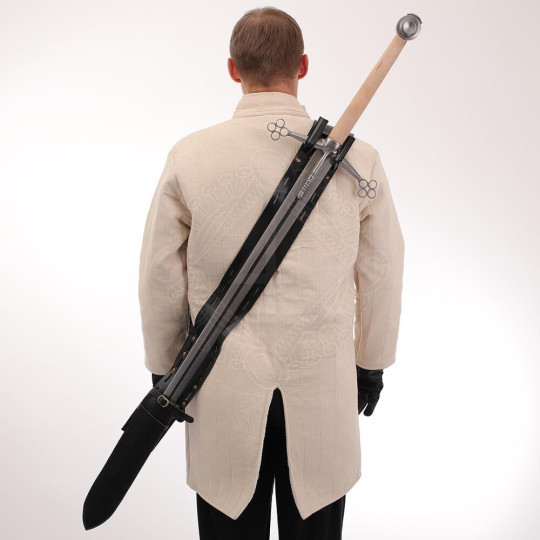
... or by being open most of the way down one side.
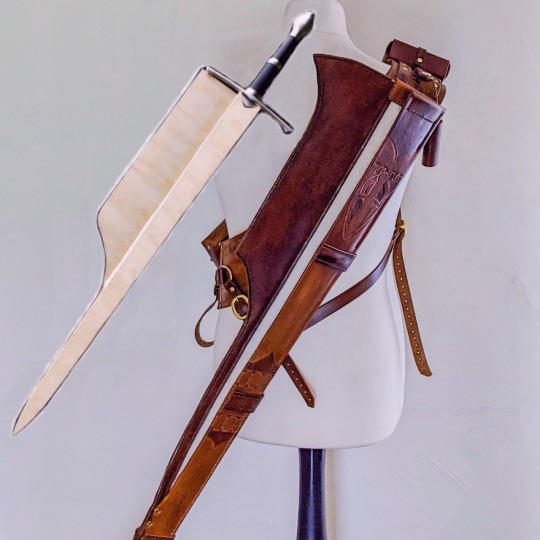
Neither are real-world historical, so let's see how they work in fantasy.
IMO they're not appropriate there either, because the designers are so eager to provide working BC / BD that they ignore the main function of a scabbard, which is to carry the weapon in something which protects people from the weapon's edges, and the weapon from the elements.
Real scabbards for real swords went to some trouble over that. They protected people, including the wearer, with a completely enclosed wooden, leather and / or metal case, and protected the blades by having them fit into their case well enough that inclement weather stayed out.
This fitting could involve metal collars (Japanese habaki), or tight-gripping lanolin-rich fleece linings, or leather flaps, caps and rain-guards mounted on hilt or scabbard-throat. Real scabbards didn't have exposed metal and weren't open-sided rainfall buckets, because the priorities of actual sword users were very different to those of back-carry fans.
Given the number of posts I've seen about the technical side of fantasy world-building - history, geography, even geology and meteorology - I think this difference is worth noting.
*****
The first time I recall seeing back-carry mentioned in a historical-not-fantasy context was in "Growing Up in the Thirteenth Century", © Alfred Duggan 1962. Here's the extract in question:
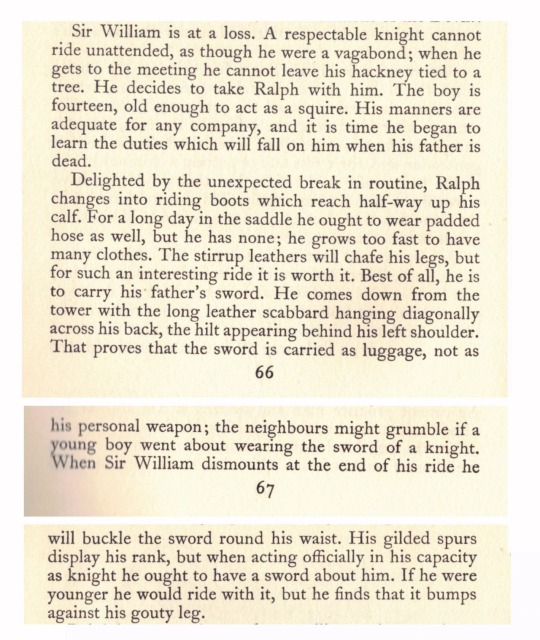
Unfortunately Duggan - though according to his Wikipedia entry "His novels are known for meticulous historical research" - doesn't give any cited source for this; his introduction to the book says:

I know the feeling! :->
I'd still trust him more than some modern historical writers who seem over-willing to add a touch of fantasy speculation / interpretation if it rounds out something inconclusive, makes the history more interesting or chimes with a personal agenda.
"Accurate" is better than "interesting", and "I don't know" is better than making stuff up.
*****
To repeat: I've yet to see any museum-exhibit or manuscript-illumination examples of BC / BD ever done For Historically Real with Western European swords, especially the hand-and-a-half longswords on which modern back-draw fans seem fixated.
A seax, scramasax or just plan sax is shorter, but yet again, this is the first time I've read anything even remotely scholarly about them or their later Viking-age version (saxes were associated more with Saxons than Vikings, guess why?) being BC / BD.
By contrast, there are at least three art instances of saxes worn horizontally, on 10th century crosses at Middleton Church, Yorkshire:

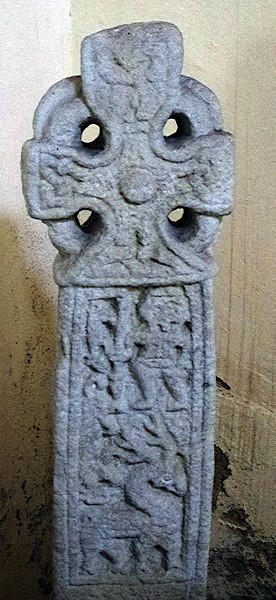
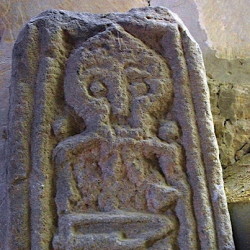
The art is backed up by surviving examples with scabbard-fittings still in place, indicating how they were worn. Here's one example, from the Metropolitan Museum, New York which makes that very obvious.
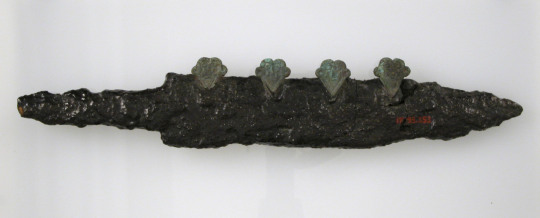
The little decorative masks (originally part of the top of the scabbard, now corroded onto the blade) are clearly meant to be This Side Up, and also show that this scabbard was This Side Out for a right-handed draw, since there's no detail on the back.
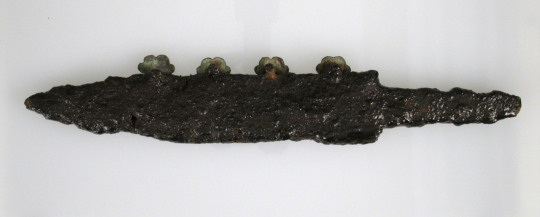
There's a similar fancy-front / plain-back / right-hand-use leather sax scabbard at the Jorvik Centre in York.
There's only a single photograph of this bigger one - 54cm (21.5 in) overall - from the Cleveland Museum of Art, with no way to see if the L-shaped scabbard mount is decorated on just one or both sides. However it does indicate the weapon was meant for horizontal wear.
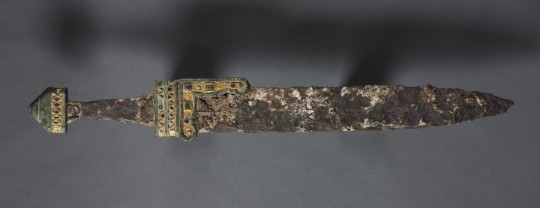
I've also flipped the website photo to show right-hand use, because "It seems..." (hah!) more probable. Here's why I did it:
For most of history being left-handed was unusual, a disapproved-of aberration and the origin of the word sinister.
Left-handers were useless in any formation from Ancient Greece through Ancient Rome to the Saxon and Viking period where the shields of a phalanx, testudo or shield-wall had to overlap for mutual support.
In the Middle Ages, both the specialised armour and the layout of jousting courses were almost 100% right-hand only.
Most surviving swords with asymmetrical hilts, such as swept-hilt rapiers, are made to for right hands not left.
Even nowadays many weapons - including the current British Army rifle (SA-80 / L85/A2) - are set for right-handers only.
*****
The longest saxes are called Langseax (surprise) though this may be a modern-ish term. Here's one from the British Museum, the so-called "Seax of Beagnoth"...

...which is 72 cm (28.5 in) total / 55cm (22 in) blade.
That's about the same as a Roman gladius (another sword never back-worn despite its convenient size) and is a good 25-30cm (10-12 in) shorter than the average "proper" sword of the same period, which means it could be drawn over-shoulder...
However the layout of its runic engraving shows it was almost certainly meant to be worn horizontally As Per Usual.
*****
And now we've come all the way back around to Prof. Price's claim that Vikings did BC / BD with their battle-knives.
Such a claim needs proof.
Please, show me some.
#arms and armour#back-carry#seax#scramasax#long knife#short sword#left-handed weapons#research#evidence
81 notes
·
View notes
Text
Bjornsson

Full Name: Bjornsson (Son of Bjorn)
Alias(es): The Wolf of the North, Ragnar’s Shadow, The Unyielding
Age: 32
Gender: Male
Occupation: Viking Chieftain, Raider, Warlord
Affiliation: His clan (Name TBD)
Status: Alive
Family:
Bjorn the Red (Father, deceased) – Former chieftain, a ruthless warrior known for his bloody conquests.
Astrid (Mother, unknown fate) – A seeress who disappeared when Bjornsson was a child.
Half-siblings (Unacknowledged) – As is common in Viking culture, Bjornsson likely has half-siblings from his father’s various concubines or wives, but he does not acknowledge them.
Appearance
Bjornsson is an imposing warrior, standing well over six feet tall, his body carved from years of battle. His long, dark blonde hair is braided back, streaked with hints of silver at the temples. His piercing ice-blue eyes are his most striking feature, cold and calculating, though they burn with something darker when fixated on YN.
A deep scar runs from his left temple to his jawline, a mark from an ambush during his youth. He wears hardened leather and chainmail, often draped in wolf pelts, signifying his status as a hunter and a leader. His arms and chest are marked with runic tattoos, symbols of protection, war, and fate.
Personality
Bjornsson is a man of contradictions. He is both calculated and impulsive, brutal yet strangely protective. His leadership is rooted in strength and fear, but he commands loyalty from his people because he is undeniably effective.
Cold & Possessive: He is not used to losing anything, let alone someone he desires. YN’s resistance only fuels his obsession.
Respected, but Feared: His people follow him not just out of loyalty, but because crossing him is dangerous.
Tactical Mind: He is a strategist, always five steps ahead, which makes escape nearly impossible.
Believes in Fate: His mother was a seeress, and though he denies believing in magic, YN’s survival against the wolf unnerves him. He sees it as a sign from the gods.
Backstory
Bjornsson was raised in the shadow of Bjorn the Red, a warlord who saw compassion as weakness. From an early age, he was trained to fight, kill, and lead.
His first kill was at age 12, when he slaughtered a rival chieftain’s son during a raid.
At 15, he was sent into the wilderness alone as a test of manhood. He killed a massive wolf with nothing but a seax knife, earning his title as The Wolf of the North.
By 20, he had claimed his father’s title, after Bjorn the Red was betrayed and killed. Bjornsson hunted down every man involved and executed them brutally.
Despite his upbringing, Bjornsson does not enjoy pointless cruelty. He is a man of war, not madness.
Past Relationships
Bjornsson has had lovers, concubines, and women offered to him, but he has never claimed anyone as his own.
Casual Affairs: He has shared beds with women out of convenience, but none have held his interest.
Marriage Prospects: He has rejected several marriage alliances, finding no woman worthy.
Why YN is Different: She is not given to him, not easy, and not afraid. She fought back. And she made a choice—to save her village—rather than be taken like a victim.
This intrigues him. This angers him. And more than anything, this makes him want her even more.
Obsession with YN
Bjornsson’s fixation on YN is different from any desire he has felt before.
The First Spark: When she wounded him during the raid, he felt shock—then excitement. A simple village girl drew his blood.
The Breaking Point: When she agreed to go willingly to save her people, it twisted something inside him. She did not beg. She did not plead. She chose.
His Logic: If the gods willed her survival, then she must belong to him.
Her defiance makes him restless. Her resistance thrills him. He adores her fire but will break her if necessary.
Life in the Settlement
YN’s arrival is met with curiosity, envy, and resentment.
The Women’s Reactions: Some resent her for holding Bjornsson’s attention, while others seek to befriend her to understand why.
The Warriors’ Reactions: His men mock him for being "soft" over a village girl—until they realize she is no ordinary woman.
The Völva’s Interest: The village seeress (Völva) is fascinated by YN’s knowledge of herbs. She claims fate brought her here.
Bjornsson relishes her struggles yet protects her fiercely. Any man who so much as looks at her too long meets a swift, brutal fate.
Trivia
He has never lost a battle.
The wolf pelts he wears are symbolic, a reminder of his first kill.
He carves runes into his weapons before battle.
He believes YN belongs to him completely—body, soul, and fate.
#yandere x darling#yandere x you#yandere x reader#yandere x y/n#yandere oc#yandere x mc#yandere#yandere ocs#yandere male x reader#yandere male x you
36 notes
·
View notes
Note
I'm hyped by your Viking AU and especially by King Øystein.
You've already addressed the animosity between Varg and Øystein, how it started and how they don't trust each other despite having to fight together. Does this bring them to play tricks on each other? Like hide the other's belongings, mess their hair or face in their sleep, etc. And does Pelle just laugh at their expense, try to stop them or play along and laugh even more at they accuse each other?
Oh, man. If it was just that..
They are looking for every opportunity to start a fight to show off their endless bravado and to dominate the other (that's what men do since forever, don't they?).
They don't trust one another. They don't share food or survival items, especially if the other is in a very bad shape after a fight or raid. They would rather let the other die a slow and painful death.
Øystein doesn't even sleep in close proximity to Varg because he knows the bastard is awake at night, sharpening his favourite knife in the dim light of the bonfire. He hears him and he knows he watches him.
Varg had to deal with hypothermia and starvation a few times because Øystein wouldn't allow him to get close to the fire. Øystein can't stand the times when Varg puts him in a bad light in front of his companions (Jan, Jørn, Metallion, Faust, etc). He knows that Vikernes wants to turn the rest against him, and he won't allow that. He's stuck with Varg ONLY because their fathers have a very good transactional relationship, and he hates that with a passion. He knows he can't just cut off Varg's head and be done, although they once had a pretty tight fight that almost ended like that.
They usually fight until blood is spilt and someone steps in (usually Pelle, but not always). Øystein has a seax (his father's sword), and Varg has an axe, so they don't hold back anything and go as straightforward as they can to stab and cut one another. It's good they have shields, lol.
One time Øystein came very close to cutting Varg's head off. He came so close to it, he almost savoured the 'It's over' moment, but he missed, and he only managed to chop Varg's hair off (pretty short, I must admit). Needless to say, Varg honor and pride were literally gone, lol. Øystein chuckled and told him, 'We're not done' before he turned his back and walked away to take care of his wounds.
Pelle took care of both of them. He's good at mediating problems (only if Øystein and Varg would listen to him). He treated their injuries and tried to keep them apart from one another.
When Varg came so close to die in that day (and lost his beloved braids), he became silent and secretly so enraged and driven to kill the king's son, he had to come with a better plan.
Øystein had no doubt that Varg would try something again, so he began waiting and waiting..
13 notes
·
View notes
Text
What Weapons Would I Use If I Was a Witcher
Hello dwarflings (and wandering travellers)! In today's yapping sessions, I thought it would be cool to talk about customised weapons I would have if I was a Witcher. I do, in fact, have a decorative Witcher sword (flexing I know haha), but with my *tiny* hands the two-handed sword is more of a 3 1/2-handed sword XD.
Instead of a typical two-handed sword, I would exchange it for either a Viking seax or a gladius sword. Ooooo maybe the steel sword Geralt has could be the gladius sword and the silver sword as seax (or visa versa). With a dagger/small knife, I'm fond of the shape of a kris knife
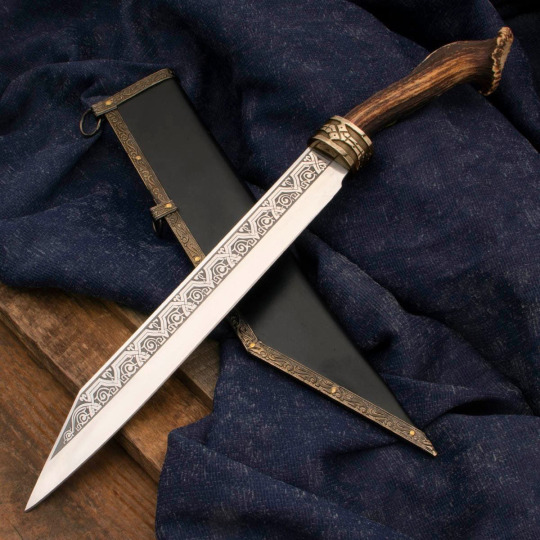
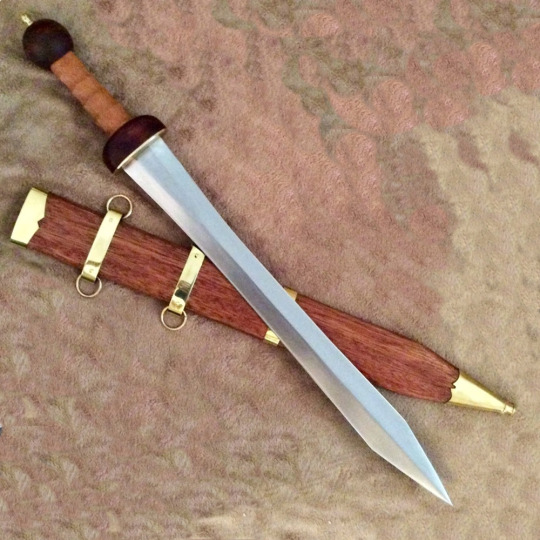

Left: Seax, Centre: Gladius, Right: Kris Knife
I know a Witcher only has two swords (and a knife kept in their boot), but There are other weapons that I think would be cool to wield. An axe for a starter. I lowkey think that axes are better to wield than swords - swords are a bit overrated haha. A great axe would be awesome as its double headed, but could be harder to manoeuvre compared to a sword.
Another type of weapon would be more specific fight against monsters sensitive to silver, especially vampires (well most of them anyway). Since I was a kid Blade has been my (marvel) superhero so I would want to incorporate some of his weapons - alongside Van Helsing - as part of my Witcher inventory. Instead of throwing knives, throwing silver stakes! Yes! if guns aren't invented in the time period where I'm a Witcher, then have a crossbow mechanism that fires the stakes.
If I was a Witcher further into the future from when the Witcher is set, I would DEFINITELY want flintlock pistols (like a pirate haha) with silver bullets.
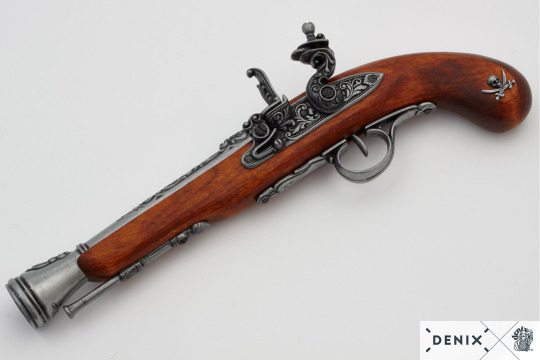
Above: Flintlock Pistol
This is all for now as me yapping about this would spread across 2 or 3 more posts haha.
Love you all.
5 notes
·
View notes
Text


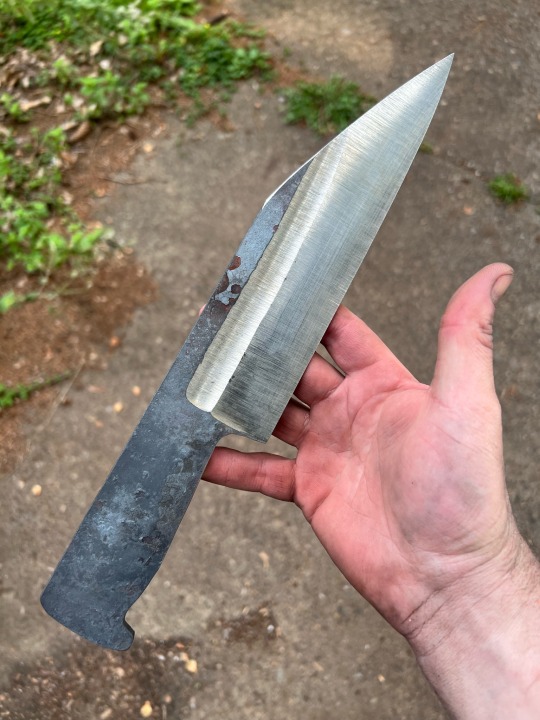
Some new blades in the works! Keep an eye out for these. Thanks everyone!!
#lunarlightforge#handforged#handmade#hand forged#handcrafted#bushcraft#seax#bushcraftknife#viking seax#dagger
102 notes
·
View notes
Text
Estrid Design #2

Redesign wip of Estrid Cadell, a character created between both me and my partner. btw I name each of these wips because I like to make proper reference sheets :)
Estrid takes inspiration from Nordic culture and times, being a viking herself. I may not be able to share all thoughts as usual because this character was planned out by my partner, I just turned his plans and designs to life.
Estrid is incredibly in touch with her culture and her people, more so than the other 3 women. Delaney was stripped of it, Cozbi pushed herself away from it, and Kanik is very in touch, but running a cult causes most to slightly distance from it. She celebrates her life amongst her people and lives with them as a typical human leader. Even becoming close to one, leading to a romantic partnership, they (gender unspecified for now) are even allowed to help her paint her body on casual days, days for training, sparring, or even war.
Typically Estrid will carry her spear and shield on her body, both of which haven't been designed yet, but once finished it'll be added to hers too. Although, she does carry an axe held at her hip, and a seax (not discussed whether it's carried daily). It's never smart to wander harmlessly.
She wears protection upon her body all the time. Tough leathers on her shoulders, as bracers on her forearms, switched as a belt around her waist, and even at her feet to protect her ankles and toes. Due to living in the mountains, each item is created with fur lining on the inside. On her chest, she wears a Brynja, which is an old Norse word meaning 'armour' or 'coat of mail', basically chainmail.
Estrid is always sparring and fighting, to train and be prepared. This is the cause of all her scars, each minor and each major. Including the horrible double scar across her face, the reason why half of her ear is missing, and the other has a cut halfway through.
On her the topic of her body, Estrid is a flat-chested and very well-built woman, but no matter how built she was, how much muscle she did or didn't have, or the size of her chest, women aren't forced to cover their chest in her region, so she'd never bind or cover it up when in casual clothing or when lacking her shirt. Binding is only ever necessary when in battle.
My next designs will cover the other 4 male characters :)
#the reawakening#original character#oc#oc art#artwork#art wip#oc reference#original art#digital art#Estrid Cadell
2 notes
·
View notes
Note
In the double legacy Au how do the gods, montera or Camp react to percies legacy? Does he meet any Northa?
In the Magnus Chase series it's said that Children of Norse gods aren't "detectable" to monsters and gods UNTIL they die. And since Sally's a Legacy of LOKI one of the Norse gods most commonly associated with like misdirection and like avoiding traps (not counting the whole ''i invented the thing that finally caught me'' thing. Please keep nets away from the Jackson family. its like their only weakness. Also Loki being the inventor of nets might have something to do with how Percy was able to host that one Egyptian god, in that one side story, who ALSO invented nets, but that's off topic) the gods just have like, no fucking clue about it. As for the whole legacy of Venus, it's so far down the generational chain that it's barely even noticable, beyond the whole ''singing-charmspeak-siren-powers'' which Sally has basically forbidden/scared?(unintentionally) Percy into never using. By the time anyone (Zeus, Ares, or other ppl who don't like Percy) realizes that Sally's and therefore Percy's heritage is cross-pantheon he's already won the favor of like- ALL the greek minor gods -(did you know that their are over 3100 immortals in the greek-mythos idk how many of that number are gods, compared to like primordials, titans, nymps, giants, and naliads but like that numbers' HUGE)- when he turned down immortality, has the begrudgingly support of Nico's dad, and has like literally saved the world twice. They can't do anything to them without like starting a war. Zeus is like trigger-happy one second from zappo murdering Percy but he CANT because Percy is the Darling. Everyone likes him now, if Zeus were to harm Percy he would have not only both his brothers to deal with but also LITERALLY everyone (minus maybe Athena and Ares) would be out for his blood.
Percy himself doesn't even find out he's a legacy until like after son of Neptune when Venus, says some shit and then his mom tells him what's up after he, Bob, and friendly giant friend get rescued from Tartarus: Ice Age Addition. to help with the final battle. (Speaking of battle Sally helps fight in the battle against Kronos in book 5, with her Seax Knives!(i remembered what her viking weapons was called!))
I have this scene in my head where like Alex Ferrari or however their name is spelt, comes to camp half blood like- 2 weeks post Dirt Fite, because she was told that they need a legacy of loki to help them complete a quest and that legacy was at the camp. and he's arguing with annabeth something like-
"Why would there be a Legacy of Loki HERE?!?!!?!"
"idk, but that's what THEY said"
Percy overhears this and is like 'No.'
'no that is nOt HaPpEnInG'
No you are not taking my mom on a quest when she is 7 months pregnant with his unborn little sister. And ends up joining the quest and that's how they find out cuz Percy asked Alex
"what generation legacy?"
And Alex is like 'why does that matter's and Percy goes off 'cuz either the gods want to force HIS MOM on a quest or they want to take a newborn and... Like...NO!!!' NOT HAPPENING. Percy rage.exe happens, there might have been an earthquake. Alex points out that Percy can just go instead. Nico is also their and ends up tagging along. He is still mad about the whole Percy saving Nico via 'distracting him with a kiss and shoving him in the elevator' in Tartarus thing. (Percy has been avoiding the subject, but now can't cuz they are stuck on a quest together) shenanigans insue.
#double legacy sally jackson au#percy jackson#sally jackson#nico di angelo#Percys already proven he's trustworthy to a majority of ppl and I'm pretty sure eboth camps would fight the gods for him#As for most gods/ppl the most common reaction is 'yeah I can see it' or 'oohhhhh' or ''....so Percy being Percy? Makes sense.''#Or if it somehow turns into a reading the books story cuz I am a sucker for those 'haha Rebellious Streak??? U mean obedience streak right?#Also I don't recognize the word montera my brain is blanking. It is. in fact. 3am.
18 notes
·
View notes
Text

Axinite aesthetic moodboard!!
Axinite:
Appearance: Axinite stands tall and formidable, embodying the spirit of a Viking warrior with his robust physique and imposing presence. His entire coloration is a deep, earthy brown, reflecting the strength and resilience forged through years of battle and survival. The eight-cut axinite gemstone glimmers proudly on his right forearm, a symbol of his lineage and prowess in combat.
His rugged features are weathered by the harsh elements of the northern lands: a strong jawline, piercing dark brown eyes that gleam with determination, and a beard braided in the traditional Viking style. Despite his imposing stature, there is a keen intelligence and a sense of honor that radiates from within him.
Attire: Axinite's attire befits a Viking warrior, combining practicality with the cultural symbols of his heritage. He wears a sturdy leather tunic adorned with brown studs and intricate knotwork patterns, providing both protection and flexibility during combat. Over his tunic, he drapes a fur-lined cape made from the pelts of northern beasts, offering warmth and insulation against the biting cold of the Viking lands.
Leather bracers encircle his forearms, each one crafted with meticulous detail and etched with runes that offer protection and blessings in battle. His brown trousers are durable and weather-worn, tucked into leather boots lined with fur to keep his feet warm and dry in the unforgiving terrain. Around his waist, a thick leather belt holds various tools of his trade, including a trusty seax (a Viking knife).
Personality: Axinite is a stoic and honorable warrior, guided by the ancient principles of his Viking ancestors. He speaks sparingly but with authority, his voice carrying the weight of experience and wisdom gained from countless raids and battles. He values loyalty, courage, and strength, holding steadfast to the warrior's code that defines his existence.
Despite his fierce reputation on the battlefield, Axinite is known for his fairness and sense of justice within his community. He acts as a protector and leader among his kin, commanding respect through both his martial prowess and his integrity. Deeply connected to the natural world, he reveres the gods of Norse mythology, offering prayers and sacrifices for guidance and favor in battle.
In addition, he is one of the Elites, a 2nd high ranked gemstone.
5 notes
·
View notes
Text
A second blade weapon became increasingly common in the later Viking Age. It does not have a formal name, being often referred to as a fighting-knife or battle-knife, and it was essentially a development of the one-handed, long seax knife of the Migration Period. A single-edged blade with a thick back that added weight to a short, stabbing blow, it seems to have been intended as a back-up weapon. By the tenth century, battle-knives had elaborate scabbards that were worn horizontally along the belt, allowing them to be drawn across the body from behind a shield if the sword was gone; a variant hung down at an angle from an elaborate harness. It seems they may also have been worn on the back - again for a swift, over-the-shoulder draw.
Children of Ash and Elm by Neil Price
@petermorwood (Mr Morwood! Mr Morwood!) I found an archaeologist claiming people were doing over-the-shoulder draws! Would you care to weigh in?
#would you care to tell me that a seax is shorter than a sword and not subject to the same restrictions#replies#Wikipedia tells me a long seax might have a 20 inch blade or longer#have as much fun as you please
2 notes
·
View notes




